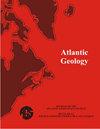Triassic palynoevents in the circum-Arctic region
IF 0.9
4区 地球科学
Q2 GEOLOGY
引用次数: 3
Abstract
Triassic successions of the present-day Arctic contain abundant and diverse assemblages of nonmarine palynomorphs that have provided important biostratigraphic information. Dinoflagellate cyst are biostratigraphically useful in marine intervals in the Upper Triassic. Based on published records, we present a compilation of 78 last occurrences (LOs), first occurrences (FOs), and some abundance events that are anticipated to have correlation potential in the Arctic region. Palynological work has been carried out in many Arctic areas, with extensive palynological research published on the Triassic successions of the Norwegian Barents Sea and Svalbard. An updated, recent palynological zonation scheme exists for that region, integrating previous schemes and illustrating the chronostratigraphic value of palynology in the Triassic. For the Lower and Middle Triassic, good ammonoid control ties the palynological zones to the chronostratigraphic scale. Independent control is sparse, and resolution is lower in the Upper Triassic, so that palynology is commonly the only biostratigraphic discipline available for chronostratigraphic dating and correlation.环北极地区的三叠纪晚期事件
现今北极的三叠纪序列包含了丰富多样的非海相孢粉组合,这些组合提供了重要的生物地层学信息。甲藻囊肿在生物地层学上可用于上三叠世的海洋层段。根据已发表的记录,我们汇编了78次末次出现(LOs)、首次出现(FOs)和一些预计在北极地区具有相关性潜力的丰度事件。许多北极地区都开展了孢粉学研究,对挪威巴伦支海和斯瓦尔巴群岛的三叠纪序列发表了广泛的孢粉学研究。该地区存在一个更新的、最近的孢粉分带方案,整合了以前的方案,说明了三叠纪孢粉学的年代地层价值。对于下三叠统和中三叠统,良好的菊石控制将孢粉带与年代地层尺度联系起来。上三叠统独立控制稀疏,分辨率较低,因此孢粉学通常是唯一可用于年代地层定年和对比的生物地层学学科。
本文章由计算机程序翻译,如有差异,请以英文原文为准。
求助全文
约1分钟内获得全文
求助全文
来源期刊

Atlantic Geology
GEOLOGY-
CiteScore
2.10
自引率
18.80%
发文量
0
审稿时长
>12 weeks
期刊介绍:
Atlantic Geology (originally Maritime Sediments, subsequently Maritime Sediments and Atlantic Geology) covers all aspects of the geology of the North Atlantic region. It publishes papers, notes, and discussions on original research and review papers, where appropriate to the regional geology.
 求助内容:
求助内容: 应助结果提醒方式:
应助结果提醒方式:


